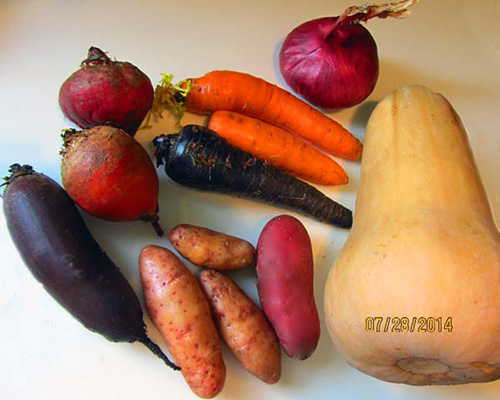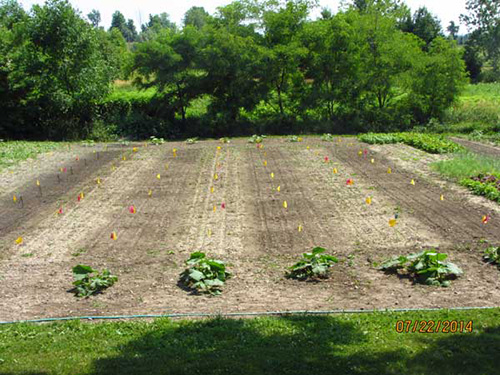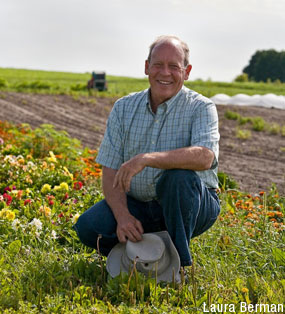Newsletters

More Profitable Market Gardening
The usual first question Market Gardeners are asked is “What do you do about bugs?” My usual reply is “They’re no longer a problem.” I long ago learned that pests are not here to bug us; they are there to fix a problem so the ecosystem can carry on as God designed it to. If I choose to not have the insect (or disease), I must then assume that insect’s job. (So I had better know the insect’s purpose before killing it.) From observation and research I learned that sucking insects are removing nitrates from the leaves that came from excess nitrogen in the soil. The solution is to reduce nitrogen fertilizer or leach it from the soil with lots of water.
Weeds have similar purposes. I have learned that thistles grow where there is soil compaction. Allowed to grow, their strong deep roots will eliminate the compaction in a few years. If I can’t wait to be free of their painfully prickly leaves, I can remove them and do their work with a sub-soiler. Pigweed’s purpose is to convert elemental potassium into a more beneficial organic form of potassium. (Pig manure is high in potassium so eventually leads to an abundance of pigweed.) Exporting the excess potassium to another farm in the form of straw is an effective way to reduce pigweed pressure.
Determining a weed’s purpose, then coming up with an alternative is more difficult than understanding insects. As a result, weeding is the largest labour expense on farms that choose to avoid chemical herbicides. To increase profitability, minimizing weed pressure is a priority. The first step is to take soil tests then systematically balance the fertility. The second is growing a couple years of cover crops. Weed pressure is typically reduced. Winter Rye with Hairy Vetch is a classic winter cover-crop. They are usually planted in the fall; then cut and disced-in the last week of May. A simpler alternative is to delay cutting until the first week of July; then shallowly till in the rye and vetch seeds to germinate for next year’s cover-crop.

With balanced soil fertility (including micronutrients) and a wide variety of soil bacteria, fungi and microbes, my experience is that vegetables taste their best. Chefs and cooks (and their diners) are more eager to purchase these delicacies, meaning their growers can obtain higher prices. Another big advantage is that these vegetables enjoy an extended shelf-life for more seasonal enjoyment. Plus they can receive winter premiums well into the new year.

To scientifically confirm which practices provide the best tasting (and longest lasting) carrots, the Organic Science Cluster at Dalhousie University was able to obtain two-years of Federal funding to conduct this Flavour Research. They transferred this to the University of Guelph’s Organic Agriculture Program. They in turn contracted me to grow the carrots under their rigorous scientific regime. In a nutshell, we are comparing:
- high chemical nitrogen levels used by conventional growers
- compost used by most organic growers
- additional micronutrients used by some growers
- biologically active compost tea used by some growers.
The harvested carrots from each treatment will be analyzed for a number of attributes. (With additional funding several supplementary analyses could be made.) Currently the plan is to record:
- Measurements of secondary metabolites
- Measurements of total soluble solids
- Professionally described flavour profiles
- Chromatography measurements of phytochemicals
- Yields, specific gravity and shelf-life.

Is Global Agriculture Sustainable?
The United Nations Commission on Trade and Development recently released a Farming Report titled “Wake Up Before It’s Too Late.” It strongly recommends a return to natural farming. (GMO’s and monocultures using dubious insecticides (neonicotinoids) and herbicides (glyphosates) are not a sustainable way to feed the world.) This report agrees with a 2008 report commissioned by the World Bank [sic] that provided similar evidence that small-scale, diverse, sustainable farms (and urban gardens) had the most potential to solve the world’s hunger problems. At the same time these will reverse modern agriculture’s devastation of our ecosystems. All 61 countries that contributed to this report agreed with the results except for the U.S., Australia, and Canada.
With the extended (and possibly permanent) draught taking place in California and the dust storms ravaging China’s topsoil, we are at some point going to be forced to once again rely on our own resources to feed ourselves. This won’t be cheap. And it is going to be even more of a challenge with an estimated 50% of our farmers retiring within the next 10 years. (75% of them do not have successors.) Ontario is already losing two farms every day. If we don’t start supporting new farmers, we can expect a huge (and unnecessarily expensive) reinvestment as we rush to rebuild this vital resource.
You Can Support Local Food Now
Food Day Canada is coming soon – Saturday, August 2nd. This is terrific way to join Canadians around the world share an all-Canadian ingredient meal. Check out the Food Day Canada website to find participating restaurants or places to join others. Otherwise create your own event and then feel free to share how you celebrated this special day. Then maybe start making this a weekly celebration.
FarmStart is a Charity committed to training new Ontario farmers. Since funding support is limited, they have recently initiated an Indiegogo Campaign to build a small greenhouse that will provide a convenient space for start-up vegetable farmers to learn how to grow their own bedding plants.
Buy your food at a Farmers’ Markets or Buy a CSA Share from a new farmer. If you feel you can provide some helpful advice, please provide it. If their quality is good, please let the farmer know. If their food is really good, pay a little extra by asking them to keep the change.
Ecological Farmers of Ontario (EFAO) is currently putting together a much-needed early December conference specifically for practicing farmers. Check for updates and Save the Date! With an expected 200 participants attending workshops, dining, networking and sleeping at the beautiful YMCA Geneva Park on Lake Couchiching, it will be a golden opportunity to share your experiences with many fellow farmers. We are expecting to have over 30 intermediate and advanced level workshops on market gardening, livestock, soil health, seed saving, field crops and more. Plus there will be some high-profile keynote speakers.
|
|||

